Prospects for the world economy
DOI:
https://doi.org/10.13133/2037-3643/9442Keywords:
Financial Crisis, Sustainability, Public Debt, Private DebtAbstract
The analysis here is founded on certain analogies with the Great Depression of the Thirties and four fundamental points: innovations, changes in the market forms, changes in income distribution and the sustainability of debts. The duration of prosperity depends first of all on the importance and variety of investment opportunities opened up by them, whereas crisis duration is conditioned by the size of indebtedness. The central problem in America today is precisely that of the sustainability of debts, to evaluate which criteria are studied in this paper. Full recovery will only be possible once past the stage in which firms and families contract debts primarily to repay other debts falling due and avoid bankruptcy. Proof that debts have fully reacquired the function of supporting growth will be given by the recovery of investments. In any case, the crisis is unlikely to reach the gravity of the Great Depression not only because a price fall is to excluded, but also because repetition of the mistakes in monetary policy are to be ruled out. Paper originally published in the BNL Quarterly Review, vol. 56 n. 226, September 2003, pp.179-206.
JEL Codes: F3, G1, N1, B5
References
CLARK C. (1937), National Income and Outlay, London, Macmillan.
EINAUDI L. (1934), "Debiti" La Riforma Sociale, vol. 45, pp. 13-27.
FISHER I. (1933), "The debt-deflation theory of great depressions" Econometrica, vol. 1, October, pp. 337-57.
GALBRAITH J. (2001), "The meaning of a war economy" Challenge, Nov.-Dec., pp. 5-12.
GODLEY W. and A. IZURIETA (2001), "As the implosion begins …? Prospects and policies for the U.S. economy: a strategic view" Jerome Levy Economics Institute.
KEYNES J.M. (1936), The General Theory of Employment, Interest and Money, London, Macmillan.
MARX K. (1977), Capital, 3 vols, reprint, Progress Publishers, Moscow.
MINSKY H. (1982), Can 'It' Happen Again? Essays on Instability and Finance, Sharpe, Armonk.
PANTALEONI M. (1910), "La caduta della Società Generale di Credito Mobiliare Italiano" in Scritti varii di economia, vol. 3, Laterza, Bari, pp. 323-615.
PASINETTI L.L. (1998a), "The myth (or folly) of the 3% deficit/GDP Maastricht 'parame-ter'" Cambridge Journal of Economics, vol. 22, pp. 103-16.
PASINETTI L.L. (1998b), "L'anomalia del debito pubblico italiano: due modi per affrontar-la" in Rendiconti dell'Accademia Nazionale dei Lincei, Roma, Classe di Scienze Morali, serie 9, vol. 9, n. 4, pp. 509-25.
SACCHETTI U. (1999), "Whither the US economy?" Banca Nazionale del Lavoro Quar-terly Review, March, pp. 69-94.
SCHUMPETER, J.A. (1939), Business Cycles – A Theoretical, Historical, and Statistical Analysis of the Capitalist Process, New York, McGraw Hill.
SYLOS LABINI P. (1948), "Saggio dell'interesse e reddito sociale" Rendiconti dell'Accademia Nazionale dei Lincei, Classe di Scienze Morali, serie 8, vol. 3, fasc. 11-2, novembre, pp. 426-53.
SYLOS LABINI P. (1964), Oligopoly and Technical Progress, Cambridge, Mass, Harvard University Press, (original Italian edition 1956).
SYLOS LABINI P. (1982), "Rigid prices, flexible prices and inflation" Banca Nazionale del Lavoro Quarterly Review, pp. 37-68.
SYLOS LABINI P. (1984), The Forces of Economic Growth and Decline, Cambridge, (MA), The MIT Press.
SYLOS LABINI P. (1998), "Sviluppo economico, interesse e debito pubblico" Rendiconti dell'Accademia Nazionale dei Lincei, Classe di Scienze Morali, serie IX, vol. 9, fasc. 3, aprile, pp. 533-44.
SYLOS LABINI P. (2000), Underdevelopment – A Strategy for Reform, Cambridge, (UK), Cambridge University Press.
SYLOS LABINI P. (2002), "Le prospettive economiche fra ripresa e recessione" Il Ponte, maggio, pp. 81-91.
VACIAGO G. (1993), "Debito pubblico versus debito privato" Moneta e Credito, settembre, pp. 331-47.
Downloads
Published
How to Cite
Issue
Section
License



